Abstract
The interest in austempered ductile irons (ADI) is continuously increasing due to their various advantageous properties over conventional ductile irons and some steels. This study aimed to determine the roles of alloying elements Ni, Cu, and Mo, on the austemperability of GGG-60 ductile cast iron. Two different sets of GGG-60 (EN-GJS-600-3) samples, one set alloyed with Ni and Cu and the other set alloyed with Mo, Ni, and Cu, were subjected to austempering treatments at 290 °C, 320 °C, and 350 °C. A custom design heat treatment setup, consisting of two units with the top unit (furnace) serving for austenitizing and the 200 L capacity bottom unit (stirred NaNO2-KNO3 salt bath) serving for isothermal treatment, was used for the experiments. It was found that austempering treatment at 290 °C increased the hardness of the Ni-Cu alloyed GGG-60 sample by about 44% without causing a loss in its ductility. In the case of the Mo-Ni-Cu alloyed sample, the increase in hardness due to austempering reached to almost 80% at the same temperature while some ductility was lost. Here, the microstructural investigation and mechanical testing results of the austempered samples are presented and the role of alloying elements (Mo, Ni, and Cu) on the austemperability of GGG-60 is discussed.
1. Introduction
Austempering is an attractive thermal process as it can turn a cast iron of appropriate composition into a new engineering material with significantly increased strength and usable ductility []. Wear resistance and fatigue properties of austempered ductile irons (ADIs) are also superior so that they can replace wrought alloys in certain engineering applications [,].
Similar to austempering of steels, austempering of cast irons also consists of three steps: (i) austenitizing of the cast iron matrix, (ii) rapid cooling to the isothermal treatment temperature, and (iii) isothermal treatment usually in the range of 250 °C–450 °C [,,,,]. However, differing than that of steels, austempering of cast iron does not aim to be a complete bainitic transformation. During the austempering of cast iron, part of the austenite matrix first transforms into ferrite and therefore the remaining part of the austenite becomes carbon-enriched; this is called a high carbon austenite (γhc). This resulting microstructure, known as ausferrite, is responsible for the outstanding mechanical properties of ADIs []. If the material is kept at the austempering temperature for a longer time, then the carbon-rich austenite (γhc) decomposes into ferrite and cementite to complete the bainitic transformation, and the mechanical properties start to deteriorate [,]. The so-called “processing window” refers to the range of austempering conditions (temperature and duration) where the ductile cast iron matrix has completed its transformation into an ausferritic microstructure (stage 1 reaction) but has not yet started to transform into a bainitic microstructure (stage 2 reaction) during isothermal treatment [,,].
The purpose of adding alloying elements into ADI is first to ensure that the austenite-to-pearlite transformation is avoided during cooling to the isothermal treatment temperature, and then to affect the austenite decomposition kinetics and mechanisms during the isothermal treatment to obtain the desired ausferritic microstructure mentioned above [,]. However, before these alloying elements affect the mentioned solid-solid phase transformations of the ductile cast iron matrix, they first influence the preceding solidification behavior to change the size (i.e., nodule count) and nodularity of graphite [,]. Therefore, the alloy design (i.e., which elements to be added and how much of them) of cast iron to be austempered should be made such that the effects of alloying on both the cast structure (graphite nodule count and nodularity) and austempering behavior are optimized together [].
Nickel, copper, and molybdenum are by far the most widely used alloying elements in both conventional and austempered ductile irons [,,,,,,,,,,,,,]. Ni and Cu are austenite stabilizers with low affinity towards carbon. Mo, on the other hand, is a ferrite stabilizer with strong affinity towards carbon and is very effective in increasing hardenability. Cast irons containing engineered combinations of these alloying elements are expected to exhibit enhanced mechanical properties after suitable austempering treatment.
The objective of this work is to contribute to the exploration of the roles of alloying elements, namely Mo, Ni, and Cu, in their combined use on the austempering behavior of conventional ductile cast iron. Rather than working on some impractical experimental alloys, the studied alloy compositions were selected to be within the conventional ductile iron compositions.
2. Materials and Methods
Two spheroidal graphite cast iron alloys (Alloy O and Alloy M) conformal to GGG-60 (EN-GJS-600-3) were prepared using an Indemak brand induction furnace with a 150 kg capacity at Ay Döküm Machine Industry and Trade Inc. (Ankara, Turkey) and poured into the molds of rectangular blocks. Then, these blocks were sliced into dimensions of about 25 mm × 25 mm × 200 mm in order to obtain samples for tensile tests after austempering under various conditions. The chemical compositions (in wt %) of these two cast iron alloys are given in Table 1. Basically, Alloy O contains Ni (0.37%) and Cu (0.52%) as alloying elements, whereas Alloy M contains 0.21% Mo in addition to Ni (0.21%) and Cu (0.41%). As Alloy M is alloyed with Mo and has reduced Ni content, the comparison of its austempering behavior with those of Alloy O should indicate the role of Mo in austemperability.

Table 1.
Chemical compositions (wt %) of the ductile cast iron alloys studied.
The sample to be austempered needs to be quickly cooled from the austenitizing temperature down to the austempering temperature, such that there will be no time allowed for any phase transformation to take place between these two temperatures. The use of an agitated salt bath is a very effective method for this purpose. In addition, a salt bath provides a suitable medium for isothermal treatment. In this study, a custom designed heat treatment setup was used for the austempering treatments.
This setup contains two units, where the top unit (furnace) serves for austenitizing and the bottom unit (salt bath) serves for isothermal treatment. The top unit is placed on a motorized tilting stage that allows quick transfer of the samples to the bottom unit through the guides. The bottom unit is a 200 L capacity, temperature-controlled salt bath filled with Petrofer AS135 heat treatment salt (NaNO2-KNO3). The salt bath is continuously stirred during operation using a motorized mixer, which ensures both efficient heat removal from the sample at the time of quenching and uniform temperature in the bath during the isothermal treatment.
In this study, in order to focus on the effects of alloying elements on the austempering behavior, the temperature and duration of austenitization for all samples were fixed at 850 °C and 90 min, respectively. Three different austempering temperatures of 350 °C, 320 °C, and 290 °C were used for a constant duration of 90 min. Austempering conditions which are graphically presented in Figure 1 and listed in Table 2 are selected to be within the “processing window” based on previous studies on similar materials [,,,,,,,].
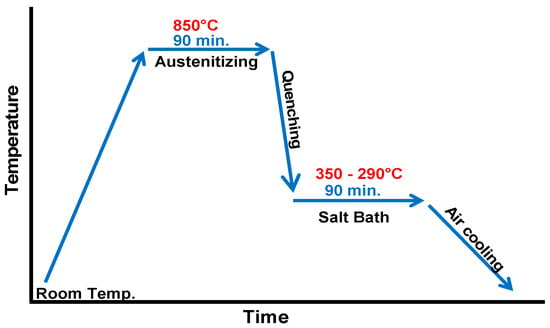
Figure 1.
Graphical representation of the heat treatment conditions.

Table 2.
Austempering conditions of the samples.
Metallographic examinations were performed on unetched and 2% nital etched polished sample surfaces using a Nikon LV 150 optical microscope (Nikon Corporation, Miyagi, Japan). ImageJ software (v151k, U.S. National Institutes of Health, Bethesda, MD, USA) [] was used to determine the nodule counts from the unetched polished samples. Five Brinell hardness measurements (HBW 2.5/187.5) were taken using an EMCO M4U 025 G3 universal hardness testing machine (EMCO-TEST GMBH, Kuchl, Austria) for each sample. Tensile testing of the samples according to ASTM E8 were done using Alşa brand tensile testing machine (Alşa Laboratuar Cihazlari, Istanbul, Turkey) at Ay Döküm in order to obtain yield and tensile strength (i.e., ultimate tensile strength) values of the samples in MPa and their ductilities in percent elongation in length (% EL). Three samples were used in each test condition.
3. Results
3.1. As-Cast Samples
The as-cast microstructures of Alloy O and Alloy M samples are presented in Figure 2. It can be seen that both samples have typical bull’s eye structures but to different extents. Alloy M has a lower graphite nodule count (356 versus 488 nodules per mm2) and more ferritic matrix surrounding the nodules. It is known that Mo has an adverse effect on nodule count [,]. With a higher count of graphite nodules (488 nodules per mm2) and a more pearlitic matrix microstructure, the average as-cast hardness of Alloy O, measured from a cross-section, was 236 HB, whereas Alloy M had a hardness of 215 HB. The surface hardness of the samples, as measured after 0.5 mm grinding, were 243 HB and 202 HB, respectively. Tensile tests showed that the as-cast Alloy O had a tensile strength of 677 MPa with 5.7% EL whereas Alloy M has a tensile strength of 576 MPa with 11.3% EL.
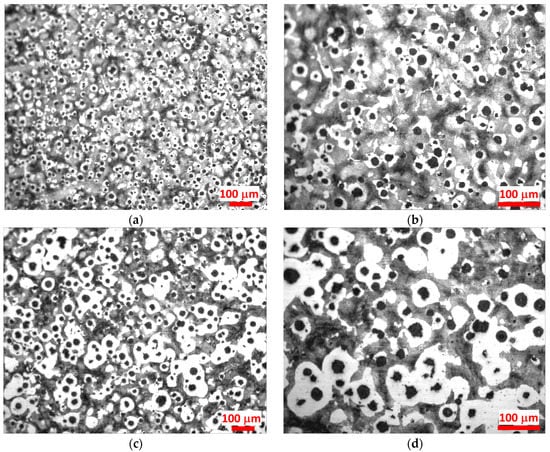
Figure 2.
Optical images of the as-cast microstructures of (a) Alloy O (100×), (b) Alloy O (200×), (c) Alloy M (100×) and (d) Alloy M (200×) (2% nital etched).
3.2. Austempered Samples-Microstructural Examination
Optical images of the microstructures of Alloy O and Alloy M samples austempered at 350 °C, 320 °C, and 290 °C are given in Figure 3. Obviously, as a result of the austempering treatment, the ferritic-pearlitic matrices of the as-cast samples shown in Figure 2 have transformed into new complex microstructures with mainly ausferritic characteristics. As expected [,], the microstructures became finer as the austempering temperature was lowered; this is especially so for Alloy M samples.
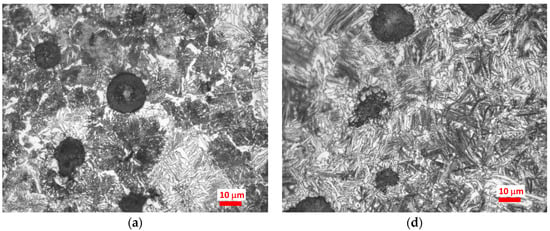
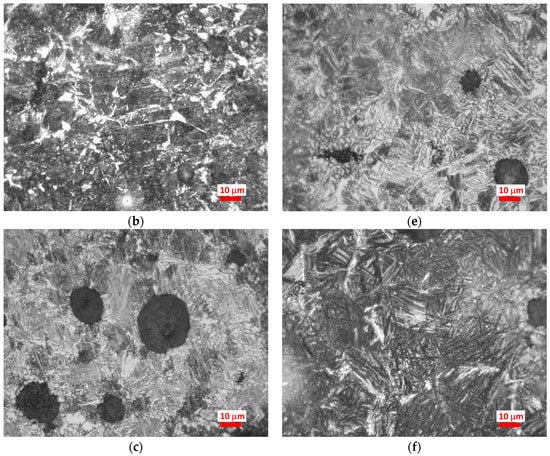
Figure 3.
Optical images of the microstructures of Alloy O (a–c) and Alloy M (d–f) samples austempered at 350 °C (a,d), 320 °C (b,e), and 290 °C (c,f) (1000×, 2% nital etched).
3.3. Austempered Samples-Hardness
The average hardness values of the Alloy O and Alloy M samples after austempering are given in Table 3. Apparently, the austempering treatment drastically increased the hardness of all samples. The hardness of Alloy O samples was measured as 299 HB, 322 HB, and 341 HB after austempering at 350 °C, 320 °C, and 290 °C, respectively. When compared to the as-cast hardness of 236 HB, these values correspond to 26.5%, 36.4%, and 44.4% increase, respectively.

Table 3.
Hardness of the as-cast and austempered samples as the average of five tests for each.
The hardness values of austempered Alloy M samples exhibited even more dramatic increases. The hardness of Alloy M samples was measured as 335 HB, 336 HB, and 389 HB after austempering at 350 °C, 320 °C, and 290 °C, respectively. When compared to the as-cast hardness of 215 HB, these values correspond to 55.8%, 56.3%, and 79.9% increase, respectively.
3.4. Austempered Samples-Tensile Tests
The tensile test results of the austempered Alloy O and Alloy M samples are given in Table 4. For the Alloy O samples, the tensile strength values were 992 MPa, 1018 MPa, and 1027 MPa after austempering at 350 °C, 320 °C, and 290 °C, respectively. When compared to the as-cast tensile strength of 677 MPa, these values correspond to 46.5%, 50.2%, and 51.6% increase, respectively. Noticeably, the improvements in tensile strengths of the samples were not accompanied by decreases in % EL. On the contrary, % EL values also slightly improved from 5.7% for the as-cast sample to 5.8%, 6.7%, and 6.3% for the samples austempered at 350 °C, 320 °C, and 290 °C, respectively.

Table 4.
Tensile test results of the as-cast and austempered samples as the average of three tests for each.
The increase in tensile strength values of the austempered Alloy M samples were even more significant; after austempering at 350 °C, 320 °C, and 290 °C, the tensile strengths of the Alloy M samples increased to 1035 MPa, 1065 MPa, and 1311 MPa, respectively. These values correspond to 79.7%, 85.1%, and 127.8% respective increases when compared to the as-cast tensile strength of 576 MPa. On the other hand, the % EL values of the Alloy M samples decreased from 8.3% EL for austempering at 350 °C to 3.5% EL for austempering at 290 °C. The increase in strength and decrease in ductility of Mo alloyed ADIs with decreasing austempering temperature was previously observed in similar studies as well [].
3.5. Effects of Austempering Temperature and Alloying
In order to gain a clear picture of the results, the variation of hardness, tensile strength, and % EL values of the as-cast and austempered samples are visually presented in Figure 4a–c, respectively. From Figure 4a, it is evident that Mo has a higher hardenability-promoting effect than Ni and Cu. In all three austempering temperatures, Mo alloyed Alloy M with reduced Ni and Cu contents reached higher hardness values than Alloy O, which was alloyed only with Ni and Cu.
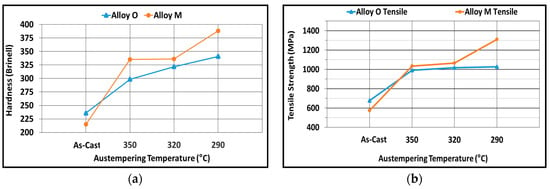
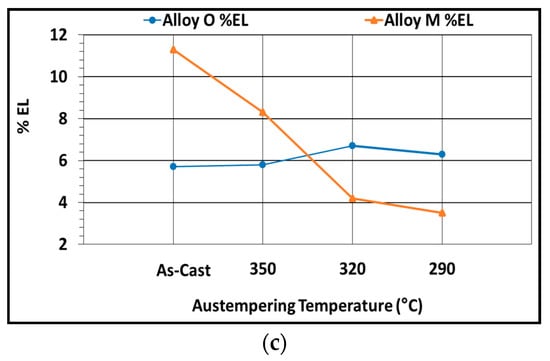
Figure 4.
(a) Hardness, (b) tensile strength, and (c) % EL (elongation in length) values of the as-cast and austempered samples.
The effect of Mo on hardenability is also reflected in tensile strength values; 1311 MPa of tensile strength attained by Alloy M after austempering 290 °C is significantly higher than that of Alloy O (1027 MPa) treated at the same temperature (Figure 4b).
It should be noted that Alloy M austempered at 290 °C comfortably meets the strength and ductility requirements of ADI Grade 1200 of European standard EN 1564 [] and falls between ADI Grade 2 and 3 of ASTM A897/A897M-03 [].
When austempered at 350 °C, Alloy M exhibits higher ductility than Alloy O (8.3% EL vs. 5.8% EL in Figure 4c) for a comparable strength (1035 MPa vs. 992 MPa). These results mean that a wider range of mechanical properties can be attained by Alloy M by choosing the appropriate austempering conditions.
Another observation to point out which is in line with some previous studies [,] is that the relatively higher Ni and Cu content of Alloy O enables the conservation of its ductility even after austempering at lower temperatures, which is not the case for Alloy M. This suggests that a new Mo-Ni-Cu alloyed ductile iron with an increased Ni content can be designed to attain higher strength values with less sacrifice in ductility after austempering.
4. Summary
Two sets of ductile cast iron samples, one alloyed with 0.37% Ni and 0.52% Cu and the other alloyed with 0.21% Mo, 0.21% Ni, and 0.41% Cu, were cast and then subjected to austempering treatments at 350 °C, 320 °C, and 290 °C.
When their as-cast states are compared, the Mo-Ni-Cu alloyed ductile iron was softer due to its higher ferrite-containing microstructure with coarser graphite nodules.
After austempering, all samples exhibited significant increases in strength. The Mo-Ni-Cu alloyed ductile iron had higher hardness, yield, and tensile strengths compared to the Ni-Cu alloyed ductile iron for all three austempering temperatures, proving the better performance of Mo as a strengthener.
The ductility of the Mo-Ni-Cu alloyed ductile iron, however, decreased as the austempering temperature was lowered. On the contrary, the ductility of Ni-Cu alloyed ductile iron slightly increased rather than decreased with the decreasing austempering temperature.
It is anticipated that by properly combining these alloying elements, it is possible to engineer ADIs to reach to various strength-ductility levels.
Acknowledgments
The authors are thankful to Özdemir Dinç for his help with the metallographic sample preparation. The publishing costs have been covered mostly by Ay Döküm Inc., with a minor contribution from Atılım University.
Author Contributions
Erkin Koç designed the composition of the alloy samples and poured them and performed tensile testing. Kazım Tur and Erkan Konca designed and performed the austempering experiments, analyzed and interpreted the data, and wrote the paper.
Conflicts of Interest
The authors declare no conflict of interest. The founding sponsors had no role in the design of the study; in the collection, analyses, or interpretation of data; in the writing of the manuscript, and in the decision to publish the results.
References
- Blackmore, P.A.; Harding, R.A. The Effects of Metallurgical Process Variables on the Properties of Austempered Ductile Irons. J. Heat Treat. 1984, 3, 310–325. [Google Scholar] [CrossRef]
- Keough, J.R.; Hayrynen, K.L. Designing with Austempered Ductile Iron (ADI). AFS Proc. 2010, 2010, 10–129. [Google Scholar]
- Tun, T.; Lwin, K.T. Optimizing the Microstructure and Mechanical Properties of Austempered Ductile Iron for Automobile Differential Gear. J. Met. Mater. Miner. 2008, 18, 199–205. [Google Scholar]
- Yescas-Gonzales, M.A. Modelling the Microstructure and Mechanical Properties of Austempered Ductile Irons. Ph.D. Thesis, University of Cambridge, Cambridge, UK, November 2001. [Google Scholar]
- Meier, L.; Hofmann, M.; Saal, P.; Volk, W.; Hoffman, H. In-situ measurement of phase transformation kinetics in austempered ductile. Mater. Charact. 2013, 85, 124–133. [Google Scholar] [CrossRef]
- Pannerselvam, S.; Martic, C.J.; Putatunda, S.K.; Boileau, J.M. An investigation on the stability of austenite in Austempered Ductile Cast Iron (ADI). Mater. Sci. Eng. A 2015, 626, 237–246. [Google Scholar] [CrossRef]
- Binczyk, F.; Hanc, A.; Kowalski, A.; Furmanek, J. Austempering transformation kinetics of austempered ductile iron obtained by Mössbauer Spectroscopy. Arch. Foundry Eng. 2008, 8, 15–20. [Google Scholar]
- Yazdani, S.; Elliott, R. Influence of molybdenum on austempering behaviour of ductile iron Part 1—Austempering kinetics and mechanical properties of ductile iron containing 0.13% Mo. Mater. Sci. Technol. 1999, 15, 531–540. [Google Scholar] [CrossRef]
- Warsisnski, K. Evauation of Thermal Stability of Ausferrite in Austempered Ductile Iron Using Differential Scanning Calorimetry. Master’s Thesis, Michigan Technological University, Houghton, MI, USA, 2017. [Google Scholar]
- Akça, C. Effect of Alloying Elements on the Austenite-Martensite Transformation in Austempered Spheroidal Graphite Cast Iron. Ph.D. Thesis, Yıldız Technical University, Yıldız, Turkey, 2005. [Google Scholar]
- Saal, P.; Meier, L.; Li, X.; Hofmann, M.; Hoelzel, M.; Wagner, J.N.; Volk, W. In Situ Study of the Influence of Nickel on the Phase Transformation Kinetics in Austempered Ductile Iron. Metall. Mater. Trans. A 2016, 47, 661–671. [Google Scholar] [CrossRef]
- Hayrynen, K.L. The Production of Austempered Ductile Iron (ADI). In Proceedings of the 2002 World Conference on ADI, Louisville, KY, USA, 26–27 September 2002; pp. 1–6. [Google Scholar]
- Hernandez-Avila, J.; Salinas-Rodriguez, E.; Cerecedo-Saenz, E.; Rivera-Landero, I.; Cardoso-Legorreta, E.; Flores-Badill, J.; Reyes-Valderrama, M.I. The Effect of Molybdenum on the Microstructure of Nodular Iron. Eur. Sci. J. 2015, 11, 377–388. [Google Scholar]
- Yazdani, S.; Elliott, R. Influence of molybdenum on austempering behaviour of ductile iron Part 2—Influence of austenitising temperature on austempering kinetics, mechanical properties, and hardenability of ductile iron containing 0.13%Mo. Mater. Sci. Technol. 1999, 15, 541–546. [Google Scholar] [CrossRef]
- Yazdani, S.; Elliott, R. Influence of molybdenum on austempering behaviour of ductile iron Part 3—Austempering kinetics, mechanical properties, and hardenability of ductile iron containing 0.25% Mo. Mater. Sci. Technol 1999, 15, 885–895. [Google Scholar] [CrossRef]
- Yazdani, S.; Elliott, R. Influence of molybdenum on austempering behaviour of ductile iron Part 4—Austempering behaviour of ductile iron containing 0.45% Mo. Mater. Sci. Technol. 1999, 15, 896–902. [Google Scholar] [CrossRef]
- Eric, O.; Jovanovic, M.; Sidanin, L.; Rajnovic, D.; Zec, S. The austempering study of alloyed ductile iron. Mater. Des. 2006, 27, 617–622. [Google Scholar] [CrossRef]
- Lin, B.Y.; Chen, E.T.; Lei, T.S. The Effect of Alloy Elements on the Microstructure and Properties of Austempered Ductile Irons. Scr. Metall. Mater. 1995, 32, 1363–1367. [Google Scholar] [CrossRef]
- Batra, U.; Ray, S.; Prabhakar, S.R. The Influence of Nickel and Copper on the Austempering of Ductile Iron. J. Mater. Eng. Perform. 2004, 13, 64–68. [Google Scholar] [CrossRef]
- Mi, Y. Effect of Cu, Mo, Si on the Content of Retained Austenite of Austempered Ductile Iron. Scr. Metall. Mater. 1995, 32, 1313–1317. [Google Scholar] [CrossRef]
- Lee, K.H.; Park, Y.W. Effects of Molybdenum on the Microstructure of Austempered Ductile Iron. J. Korea Foundry Soc. 1994, 14, 35–44. [Google Scholar]
- Thomas, T. Molybdenum in Ductile Iron, Hot Topics Issue #1; Ductile Iron Society: Strongvilee, OH, USA, 2007. [Google Scholar]
- Guzik, E.; Sokolnicki, M.; Krolikowski, M.; Ronduda, M.; Nowak, A. Prediction of Microstructure in ADI Castings. Arch. Metall. Mater. 2016, 61, 2159–2164. [Google Scholar] [CrossRef]
- Zhang, J.; Zhang, N.; Zhang, M.; Liantao, L.; Zeng, D. Microstructure and mechanical properties of austempered ductile iron with different strength grades. Mater. Lett. 2014, 119, 47–50. [Google Scholar] [CrossRef]
- Sahoo, S.K. A Study on the Effect of Austempering Temperature, Time and Copper Addition on the Mechanical Properties of Austempered Ductile Iron. Master’s Thesis, National Institute of Technology, Rourkela, India, 2012. [Google Scholar]
- Rasband, W. ImageJ; U.S. National Institutes of Health: Bethesda, MD, USA, 1997–2016.
- Guesser, W.; Koda, F.; Martinez, J.; Martinez, J.A.B.; Silva, C. Austempered Ductile Iron for Gears; SAE Technical Paper 2012-36-0305; SAE International: Warrendale, PA, USA, 2012. [Google Scholar]
- BSI (British Standards Institution). EN 1564:2011 Founding—Ausferritic Spheroidal Graphite Cast Irons; BSI: London, UK, 2011. [Google Scholar]
- ASTM International. ASTM A897/A897M—03 Standard Specification for Austempered Ductile Iron Castings; ASTM International: West Conshohocken, PA, USA, 2003. [Google Scholar]
© 2017 by the authors. Licensee MDPI, Basel, Switzerland. This article is an open access article distributed under the terms and conditions of the Creative Commons Attribution (CC BY) license (http://creativecommons.org/licenses/by/4.0/).